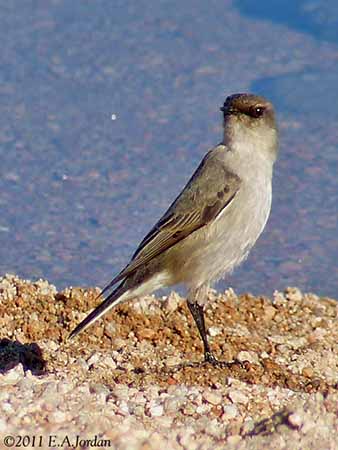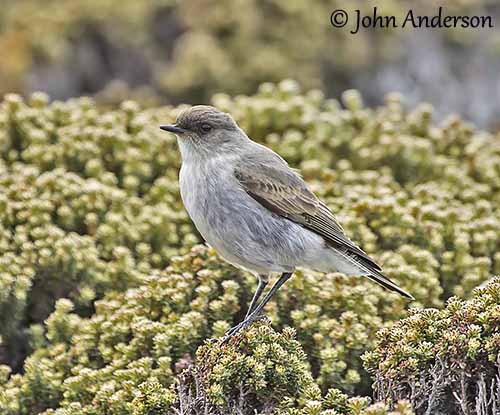
Fr: Dormilon bistré
All: Maskengrundtyrann
Esp: Dormilona Carinegra
Ita: Tiranno terricolo facciascura
Nd: Maskergrondtiran
Sd: Svartkindad marktyrann
Photographers:
John Anderson
John Anderson Photo Galleries
Eduardo Andrés Jordan
MIS AVES – AVES DE ARGENTINA
Otto Plantema
Trips around the world
Text by Nicole Bouglouan
Sources:
HANDBOOK OF THE BIRDS OF THE WORLD Vol 9 - by Josep del Hoyo - Andrew Elliot - David Christie - Lynx Edicions - ISBN: 8487334695
BIRDS OF SOUTH AMERICA – Passerines - by Robert S. Ridgely and Guy Tudor – HELM Field Guides – ISBN: 9781408113424
BirdLife International (BirdLife International)
Wikipedia, the free encyclopaedia
Dark-faced Ground-tyrant
Muscisaxicola maclovianus
Passeriformes Order – Tyrannidae family
INTRODUCTION:
The Dark-faced Ground-tyrant is included in the huge family Tyrannidae, subfamily Fluvicolinae (group Fluvicolini). These species are associated with open country South of Amazonia and temperate grasslands of Southern Andes.
The nominate race of this species occurs in Falkland Islands where it is resident and breeding species.
DESCRIPTION OF THE BIRD:
Biometrics:
Length: 17 cm
Weight: 20 g
The adult has dark brown to grey-brown upperparts with darker wings. Lower rump and tail are mostly black. The outermost rectrices show white outer webs.
The underparts are pale grey, with white belly, vent and undertail-coverts.
On the head, forehead, lores and cheeks are blackish, whereas the crown is dull chestnut-brown.
The short, pointed bill is black. The eyes are dark brown. Legs and feet are black.
Both sexes are similar.
The juvenile has streaked throat and pale buff edges to wing-coverts.

SUBSPECIES AND RANGE:
Two subspecies are recognized:
M.m. maclovianus (here described) is found in Falkland Islands.
M.m. mentalis is found in S Chile and S Argentina. It winters N to N Peru, NE Argentina and Uruguay. This race is much smaller than nominate.
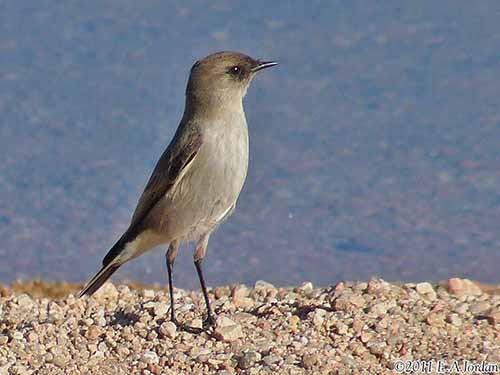
HABITAT:
The Dark-faced Ground-tyrant frequents mainly open habitats such as heath and grassland, from the coasts to the mountain tops. It can be seen on high Andean slopes in open meadows near forest, but also in marshy areas in valleys, in vicinity of rivers.
Outside the breeding season, it can be found in pastures and grasslands, sandy deserts or beaches. Along the coast, it occurs on and near the dry kelp beds and the floating seaweeds.
This species is visible below 1200 metres, but rarely to 2500 metres of elevation.
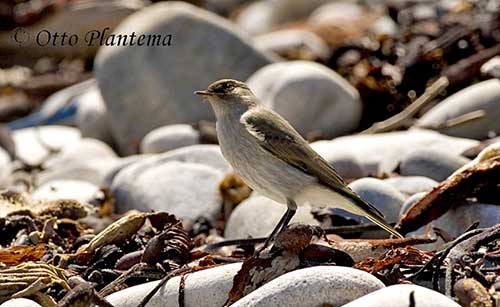
CALLS AND SONGS: SOUNDS BY XENO-CANTO
The Dark-faced Ground-tyrant is tame and silent by nature. But it often utters a weak call. The alarm call is a series of loud “chip”, and rapid “tu” or “chee-tu”. In flight, it gives a tiny “zilip”.
The territorial song is a warbling series of several notes.
BEHAVIOUR IN THE WILD:
The Dark-faced Ground-tyrant is an insect-eater and feeds on a variety of invertebrates.
It is mainly terrestrial when foraging, hunting among rocks, heath, grassland and rotting seaweeds (in Falkland Islands), searching for terrestrial and marine invertebrates.
But it also catches insects on the wing.
On the ground, it hops and runs after preys, then stops suddenly while standing erect. It may also hover with spread tail while searching for preys on the ground.
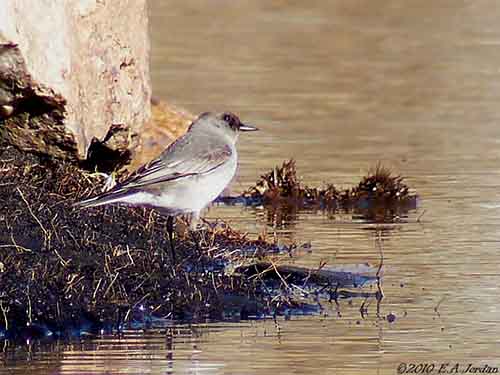
It is usually seen alone or in pairs. However, outside the breeding season, they often form loose flocks of up to 100 individuals.
During the breeding season, the male performs courtship displays. It rises into the air, up to 15-16 metres, and drops to the ground. There, in front of the female, it moves its wings up and down. When breeding, it is more arboreal than other ground-tyrants, and often perches in low trees at woodland edge.
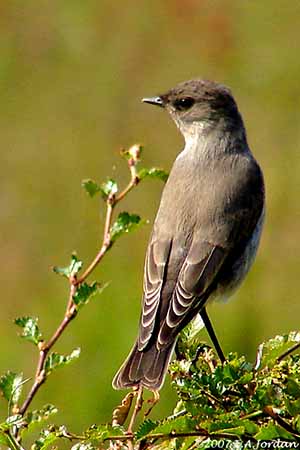
The Dark-faced Ground-tyrant is resident in Falkland Islands. But the continental race “mentalis” is migratory. It spends the austral winter (April/October) along the W coast to N Chile and Peru, and NE to N Argentina and Uruguay.
The flight is agile and allows the bird to catch insects on the wing.
REPRODUCTION OF THIS SPECIES:
The breeding season occurs between September and March for the race “mentalis”, and in October/December in Falkland Islands for the nominate race.
The nest is placed in crack or hollow between rocks. This is a cup made with grass and occasionally rootlets. The inner cup is lined with softer materials such as feathers and wool.
In Falkland Islands, the nest is a deep cup made with the same type of materials. It is placed under rock crevices or stone runs.
The female lays 2-3 eggs. No information on incubation period. The chicks fledge 18 days after hatching.
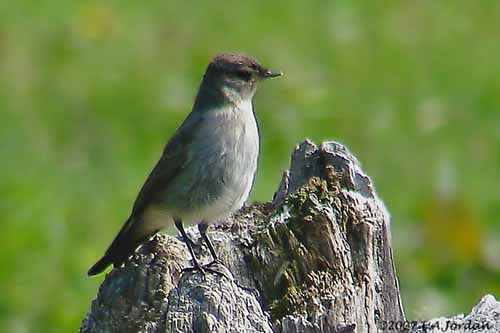
PROTECTION / THREATS / STATUS:
The Dark-faced Ground-tyrant is common but in Falkland Islands, the nominate race depends largely on weather conditions and is vulnerable to harsh winters. The main predator is the domestic cat.
The Falkland population is estimated at about 20,000 breeding pairs.
The populations living at high elevation are probably at lower risk than those living in grasslands. These areas are destroyed by overgrazing and agriculture.
However, the Dark-faced Ground-tyrant is currently evaluated as Least Concern.
